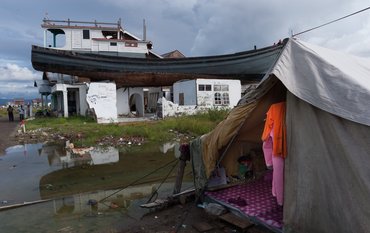New data on the 2023 water balance
22 March is World Water Day. Supposedly ubiquitous, water has long since become a precious and scarce resource in many parts of the world. Climate change has exacerbated the situation in many places. Germany has also experienced drastic droughts in the past five years. For the year 2023, researchers led by Eva Börgens and Christoph Dahle from the GFZ German Research Centre for Geosciences have now evaluated the latest data set from the GRACE-Follow-On satellite duo, which has just been completed and provides precise insights into the Earth's water balance based on gravity field measurements. They show that although the total water reservoir in Germany has recovered somewhat in 2023, there is still a shortfall of around 10 billion tonnes compared to the long-term average. For comparison: Lake Constance holds around 48 billion tonnes of water. In Europe, the total water storage has decreased by around 100 billion tonnes compared to the average since measurements began in 2002. However, no clear trend can be derived from this at present.
Total terrestrial water storage (TWS) is made up of the water cycle components ice (i.e. glaciers), snow, soil moisture, groundwater and surface water in rivers, lakes and artificial reservoirs. TWS is an important parameter for environmental and climate research. It is now officially one of the 54 "Essential Climate Variables", which make a decisive contribution to characterising the Earth's climate and are an important basis for the work of the IPCC (Intergovernmental Panel on Climate Change). The TWS is provided by the German-American GRACE-FO mission.
The gravity field missions thus not only provide valuable data on water on and below the Earth's surface, but also on the mass balance of the large inland ice sheets over Greenland and the Antarctic. The trend here is dramatic: every year Greenland loses around 224 billion tonnes of ice and the Antarctic, which is much colder, 138 billion tonnes.
New GFZ information portal on global water storage
This and other current and background information on the GRACE satellite missions, their measuring principle and data analysis, but also on research projects as well as animations and maps can be found in the new information portal globalwaterstorage.info, which the GFZ has set up. For example, an animated time series can be found here, which impressively shows how Europe's total water storage has become smaller and smaller since 2002. Fact sheets and thematic dossiers complete the offer, which is aimed in particular at representatives of the national media and political decision-makers, but also at the general public.
Gravity field mission will be continued and will also provide important water and climate data in the future
Since 2002, the tandem satellites of the GRACE mission and, since 2018, the subsequent GRACE-FO mission, have been providing important data for climate monitoring: GRACE stands for Gravity Recovery and Climate Experiment. It is a joint mission of NASA, the German Aerospace Centre DLR and the German Research Centre for Geosciences GFZ together with other research and industrial partners. The satellites make it possible to continuously monitor the Earth's gravitational field. Based on its minute changes, temporal and spatial changes in the global water and ice balance can be determined - and thus also the influence that climate change has on it.
The research institutions in the USA and Germany involved in the GRACE missions, the industrial partners and the Federal Ministry of Economics and Climate Protection (BMWK) and the Federal Ministry of Education and Research (BMBF) have agreed to continue the mission: GRACE-C is expected to launch in 2028 and will continue to measure the Earth's gravitational field. This will ensure that the Earth's water cycle can be measured over a period of at least around 30 years – a period that is considered the climate period.
Further information on the new GFZ information portal :
https://www.globalwaterstorage.info/en/
Illustrations for download:
https://nextcloud.gfz-potsdam.de/s/Y3QAqryrbWxTLRL
(The GIF in Fig. 0 will only be played if the file has been downloaded beforehand).
Captions
Fig. 0: Water deficit annual balance 2023
Average water deficit in Germany - by month for the year 2023 and as a GIF in the summary. The reference value for each month is the average of all respective months since the start of GRACE measurements in 2002.
Copyright: Eva Börgens, Christoph Dahle (GFZ)
Fig. 1: Drought in Germany mean water deficit since 2018
Mean water deficit in Germany over all months since 2018. The reference value for each month is the average over all respective months since the start of GRACE measurements in 2002.
Copyright: Eva Börgens, Christoph Dahle (GFZ)
Fig. 2: Drought Europe mean water deficit since 2018
Mean water deficit in Europe over all months since 2018. The reference value for each month is the average over all respective months since the start of GRACE measurements in 2002.
Copyright: Eva Börgens, Christoph Dahle (GFZ)
Fig. 3: Timeseries Germany since 2002 (without annual signal)
Time series of the deviation of water masses in Germany from the monthly average values since the start of measurements in 2002. The slight recovery can be seen from the second half of 2023, which goes beyond the normal seasonal fluctuations (wet winters).
Copyright: Eva Börgens, Christoph Dahle (GFZ)
Fig. 4: Timeseries Europe since 2002 (without annual signal)
Time series of the deviation of water masses in Europe from the monthly average values since the start of measurements in 2002. The slight recovery can be seen from the second half of 2023, which goes beyond the normal seasonal fluctuations (wet winters).
Copyright: Eva Börgens, Christoph Dahle (GFZ)
Fig. 5: Water storage spiral until Oct 2023
The animation shows the changes in total water storage (compared to the long-term average) for Europe in the period from April 2002 to October 2023. The further out the line runs, the more water was stored at that time. After several more or less stable years, water loss has increased significantly in recent years.
Copyright: Eva Börgens, Julian Haas (GFZ)
Fig. 6: Ice mass change in Greenland 2002-2023
Copyright: Eva Börgens, Julian Haas (GFZ)
Fig. 7: Change in ice mass in Antarctica 2002-2023
Copyright: Eva Börgens, Julian Haas (GFZ)



![[Translate to English:] Two maps: left Germany, right Central Europe. Layer above with rectangular zones in various shades of red.](/fileadmin/_processed_/f/0/csm_Web-1-Abb1_2_Duerre-D-seit-2018_6b04537a8a.png)
![[Translate to English:] Data curve jagged. Values decrease with increasing number of years. Slight increase at the end.](/fileadmin/_processed_/9/3/csm_Web-2-Abb3_Zeitreihe-D_6d14f57795.png)




![[Translate to English:] Fire in a forest, smoke rising, aerial view from above](/fileadmin/_processed_/8/3/csm_2025_01_06_AdobeStock_415831729_5a0e6d50d3.jpeg)









![[Translate to English:] [Translate to English:] Abror Gafurov von dem Schriftzug "Welcome to Azerbaijan" und den UN und COP Logos](/fileadmin/_processed_/2/5/csm_2024_11_Baku_COP29_Abror_Gafurov_1042faec82.jpeg)


![[Translate to English:] Martin Herold standing in front of the library on the Telegrafenberg](/fileadmin/_processed_/c/d/csm_Martin_Herold_d385ee4dd9.jpeg)
![[Translate to English:] Many people are listening to a presentation in the GFZ lecture hall.](/fileadmin/_processed_/c/a/csm_1_Bild1_hell_b9c0e9f5ed.jpeg)






![[Translate to English:] Both scientists sitting on stools in front of a wall of books in the Telegrafenberg library](/fileadmin/_processed_/6/6/csm_Buiter_Castell_DORA_4_e87cb1ea18.jpeg)
![[Translate to English:] Gruppenbild mit 4 Personen](/fileadmin/_processed_/8/d/csm_20241017_GFZ-Emmerman-Medal-005_web_reinhardtundsommer_21a414fa4a.jpeg)






![[Translate to English:] Ice landscape with five red tents](/fileadmin/_processed_/8/9/csm_Zeltlager_auf_dem_Eis_Urheberin_Jenine_McCutcheon_5ced2d523b.jpeg)